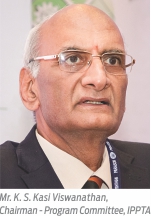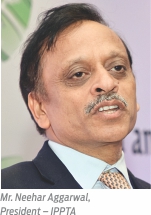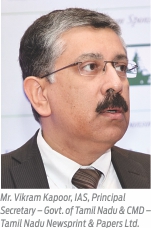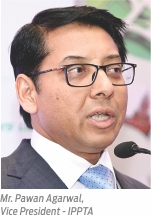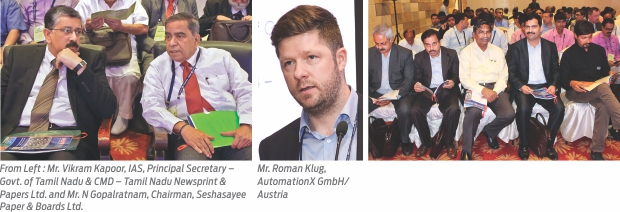IPPTA’s earnest effort to reconcile the business viability with the environmental sustainability, in the light of ongoing climate change debates worldwide and increasing normative pressure from authorities in India, is vindicated by increasing thrust on clean and green practices and technology in its seminars and conferences.
Green and Clean Best Practices and Technologies in Paper Manufacturing was the principal theme for IPPTA’s 53rd annual general meeting held from March 3-4, 2017 in Chennai. The theme covered a host of subjects and topics under serious consideration of the pulp and paper industry globally including India. Environment and sustainability now have become real, no longer a lip-syncing business! The two-day event witnessed a humungous gathering of delegates from the Indian pulp and paper industry along with a number of papers presented by the Indian and foreign industry experts, mostly on energy savings, sustainable plant optimization, performance improvement, plastic waste disposal, conservation of resources, bio-based energy generation, etc. IPPTA of late has been successful to a large extent in capturing attention of the industry on themes related to environment, whereby the industry increasingly has grown as convinced that measures and investments addressing environment and sustainability is not a waste and have become all time necessities.
In the inaugural session, the addresses delivered by the keynote speaker Mr. N. Gopalaratnam, Chairman, Seshasayee Paper & Boards Ltd. and the Chief Guest Mr. Vikram Kapoor, IAS, Principal Secretary, Govt. of Tamil Nadu encapsulated some major environmental and operational issues of the industry along with probable steps to be taken in order to address those. The outgoing president Mr. Neehar Aggarwal recounted his two-year stint and the efforts taken in order to make IPPTA a stronger, aware, well-connected and resourceful body. Mr. Pawan Agarwal, Vice President, IPPTA would be the new president of the body.
Continuously Evolving Indian Paper Industry
Mr. K. S. Kasi Viswanathan, Chairman – Program Committee, IPPTA, welcoming the guests and giving an outline of the seminar said, “I always say, in all our meetings, that we are proud to be part of an industry like paper. We may have some problems in our day-to-running but, at the end of the day, it’s a great industry and paper is a wonderful product, key to education and spreading literacy. The industry moreover generates huge employment, especially in rural areas.”
Mr. Viswanathan also spoke on how the industry over a period of time has evolved technologically and its processes became increasingly efficient. “Some 20 years back, as I remember, we used to use too much chlorine and used to have enormous issues in dealing with its side-effects. The industry has come a long way since then and more use of oxygen, hydrogen peroxide, and other environment-friendly chemicals is finding place in our processes,” he said.
Speaking further on how the paper is farmer-friendly and employment-generating, Mr. Viswanathan said, “Three basic raw materials, i.e. wood, agro-residues, and recycled fiber have become area-specific products now. While it takes 20 years for teak to grow in Scandinavia, wood has become a short-cycle, sustainable product in the tropical countries. Thanks to enormous effort put by the industry in coordination with universities, scientists, and tree-growing experts! Today, the wood is predominantly sourced from social forestry, helping the farmers immensely. Industry now plants more trees than it can use. Next are the bagasses and other agro-residues such as rice and wheat straw, which again are agricultural products and help farmers. Likewise, the collection, segregation and processing of waste paper generate huge employment for the poor people.”
“Having said that, the Indian paper industry is passing through interesting but tough times; market is unpredictable; availability of key inputs like water and fiber is under stress; environmental regulations are becoming stringent to reduce the water usage and effluent discharge at the same time,” said Mr. Viswanathan. “To add to this, there is immense pressure on all of us from schemes like PAT, REC, RPO, and so on. We therefore must try to become competitive by using all our resources well and eliminating all forms of waste. This is where the present topic of the seminar Green and Clean Best Practices and Technologies in Paper Manufacturing becomes highly appropriate. The seminar is going to concentrate on the recycle and reuse of water by reducing the waste water and overall water footprint, efficient use of energy to reduce the carbon footprint, reduce the waste generation along with managing the waste.”
Climate Change and Sustainability are Real Now
Mr. N. Gopalaratnam covered the theme of the seminar much broadly in his address and took the entire discussion on another level by infusing myriads of perspectives of climate change beyond the industry level and linked how the fundamental notion of climate change and sustainability of environment is affecting the entire industrial ecosystem, including the paper industry. He started out with giving a succinct definition of ‘clean’ and ‘green’. “Green is sustainable and is something which can be effortlessly recycled. We should be able to recycle waste and pollutants at source. Moreover, green is something which is promoting innovations in good health and clean environment. However, clean technology, product, or process is something which reduces waste and which uses minimum non-renewable resources. Here, you may use some non-renewable but not much,” he said.
Mr. Gopalaratnam also emphasized the growing significance of terms like ‘climate change’ and ‘sustainability’ in recent years and said that these concepts have become a real concern for the entire globe because of the related short-term and long-term effects cast on humanity. He went on to tracing the origin of two terms to Rio Summit, 1992 and also gave their official definition. Mr. Gopalaratnam also said that the terms global warming and climate change should not be used interchangeably as they have different meanings. “However, especially in the context of environmental policy, the term climate change has become synonymous with anthropogenic global warming. Within scientific journals, global warming refers to surface temperature increases while climate change includes global warming and everything else that increasing greenhouse gas levels affect. Generally, climate change is a change in the statistical distribution of weather patterns when that change lasts for an extended period of time and is relatively permanent in nature,” he said.
Mr. Gopalaratnam went on to spell out various consequences that climate change have on the earth, especially the forests. “Forests provide many benefits and services to society, including clean water and air, recreation, wildlife habitat, carbon storage, climate regulation, and a variety of forest products. About 1.6 billion people, which are nearly 1/5th or 1/6th of world’s human population, are dependent on forests and their life gets threatened by the degradation of forests. Many aspects related to climate change are likely to affect forest growth and productivity. The increases in temperature, changes in precipitation, and increases in carbon dioxide (CO2) are likely consequences of the climate changes which may affect the forests perniciously causing huge disturbances in rainfall patterns thereby affecting the food security,” he said.
Speaking further on the causes of this conspicuous climate changes, Mr. Gopalaratnam attributed most of it to the large scale use of fossil fuels by the industrialized nations. “If we really want to have a good scenario, which is called ‘climate neutral’, we need to use more and more biomass energy in place of fossil fuel based energy. And, even better scenario, called ‘climate positive’, can be attained only when you completely switch to clean energy sources like solar and wind,” he added. “I think that by all account the real culprit is coal, a source of nearly 40 percent of all energy generation and which touches a 70 percent mark in India’s case. The large scale use of coal is primarily responsible for significant part of manmade CO2 emissions. “Every second we are releasing about 1000 tonnes of CO2 and unless there is adequate source of absorption of this CO2, which are tress of course, we won’t be able to prevent the heat being trapped by the extra CO2 . Consequentially, the average global temperature is going to go up, at least by half a degree Celsius every 20 years.”
Connecting it to the paper industry, Mr. Gopalaratnam said, “All this has a role to play in the paper industry. In order to make this product, we are also not that kind on the nature and environment. That’s where today’s theme of the seminar becomes much relevant. The GHGs emission is largely because of high energy requirements in various industries, including the paper industry. The consumption of fossil fuels in our boilers, turbines, incinerators, lime kilns is directly contributing to overall GHGs emission. Moreover, we also generate CH4 in our process – mainly from the treatment of wastewater and dumping the paper to biodegrade.
Mr. Gopalartanam exhorted the Indian paper industry to take strong sustainable initiatives to address the challenges posed by climate change on the lines of other industrialized nations. Industries in Europe are handling the issues related to climate change very effectively, he said. “In Europe, 55-60 percent of the energy required by the pulp and paper industries is met with biomass energy, especially CH4 – wood, black liquor, bark, etc. are used effectively to generate fuel. Europeans also have set some voluntary targets, which probably the Indian pulp and paper industry should also do. They have set the CO2 reduction target at 30 percent by 2020 from 1990 levels and would like to take this further to 50 percent by 2050. They are using the best available technologies irrespective of cost and are fast switching from conventional fuel to non-conventional and bio-fuels,” he added.
“In the US, the Agenda 2020 Technology Alliance, a non-profit organization, exists to identify high priority, pre-competitive technology challenges for the pulp and paper industry and to promote scientific research and development projects to address them. Agenda 2020 technology roadmaps published in April 2016 chart pathways to advanced manufacturing technologies for enhanced sustainability, efficiency, and competitiveness. The aims of the research are to reduce purchased energy and water use per ton by 50 percent. Success would mean savings of more than 200 trillion But and 480 million gallons of water discharge per year. Another roadmap seeks to develop new biobased products worth USD 5 billion in sales annually,” informed Mr. Gopalaratnam.
He also added that pulp and paper sector’s commitment towards environment is largely driven by customers in the US. “Made aware by the NGOs, customers insist on a paper consisting at least 30 percent recycled and are willing to pay more for 100 percent recycled fiber based paper. These are the customers necessitating the US pulp and paper producer to comply with the environmental standards in making paper. In the US, there is large scale emphasis now on to making a paper using recycled fiber, which means India may have to struggle for its recycle paper import from the US in future and prepare itself for such contingencies by revamping our own waste collection methodologies,” said Mr. Gopalaratnam.
“The Indian Govt. has also committed to reduce carbon emissions relative to its GDP by 33 percent to 35 percent from 2005 levels by 2030. India also pledged that 40 percent of the country’s electricity would come from non-fossil fuel-based sources, such as wind and solar power, by 2030. These commitments are the origin of our RECs, PATs, etc. The industry on its parts has also come up with certain initiatives, for example, CII’s GreenCo rating System and Product Stewardship program. Whereas the Green Co Rating is based on company’s exemplary performance in energy & water efficiency, technology, waste management, green supply chain etc., Product Stewardship is all about influencing suppliers to comply with the company’s requirements and reducing the negative impact of the product by minimizing hazardous chemicals,” said Mr. Gopalaratnam. “A paper producer must not resort to using unwarranted substances for a quality which is otherwise not required by the customer. Likewise, the industry should always go for the life cycle assessment of the products, i.e. you must assess your products throughout its entire life cycle from the design stage to final consumption.”
Efficient Process and Best Technology
Admitting that the Indian paper industry continues to be the fastest growing market globally, Mr. Neehar Aggarwal projected much better times for the industry in future. “With 15 million tonnes production annually and only 13 kg per capita consumption, there is much traction in the market, especially when markets in Europe and the US are shrinking,” he said.
Mr. Aggarwal however questioned the long-term sustainability of the Indian paper industry. He said that the industry’s long-term sustainability is not being affected as much by the challenges like the raw material scarcity and energy cost as it is by the small scale assets in India, from competitiveness view-point. “Small scale assets are keeping India back as far as competiveness of the Indian paper industry is concerned with its peers such as Brazil and China,” he said.
He added, “In Brazil, we have company-owned, large, consolidated plantations on millions of hectares whereas in India we are dependent upon farm forestry, which are individually of 1 or ½ acre size with small and marginal farmers planting wood. If you look at some of the statistics, yield from plantations in Brazil is 40 m3/hectare/year whereas it is only 15-20 m3/hectare/year in India; the productivity in Brazil is 10-20m3/man-hour whereas in India it is 2-3 m3/man-hour; a truckload of wood in Brazil would be at least 50-60 tonnes, which in India is just 10-15 tonnes, indicating a higher logistics cost for similar haulage; the catchment area in Brazil for a million tonne pulp mill is around 50-100 km which becomes 500 km in India’s case. As a result, the cost of raw material in India, though the scenario is improving, is about 60 percent higher than in Brazil. These are the numbers affecting the Indian pulp and paper industry’s global competitiveness.
“The largest paper mill in India is about 300,000 tonnes whereas it is about 2 million tonnes in case of Europe, Brazil, and China. The largest paper machine in India would have typically a capacity of 150,000-200,000 tonnes whereas the capacity of ordinary machines in China would be ½-1 million tonnes. Our small scale of operation is putting us in a lot of other disadvantages. The only advantage of our smallness is that the Indian printing industry is also very fragmented and smaller units find themselves adequate to cater to the requirements of these printers. Else, we are uncompetitive as far as cost is concerned.”
Mr. Aggarwal suggested that solution lies in making operations cost efficient and the Indian paper industry should adopt a two pronged approach in doing so – first is process based solutions for optimizing the use of resources and the other is adopting the best in terms of technology, i.e. for boilers, continuous digesters, etc. He said that by adopting this approach the Indian paper industry would not only achieve the resource optimization and cost effectiveness but would be able to align itself with required environmental compliance. “India targets to reduce its emission intensity by 30-35 percent by 2030 from 2005 levels, which is a very huge reduction at a time when rapid industrial growth is happening. India also expects to generate 40 percent of all its energy needs from non-fossil fuels, which again is an enormous task,” he said. “One way to reduce the emission intensity is to consume less energy than we are consuming now, i.e. find ways to enhanced energy efficienecy.”
“For enhanced energy efficiency, the Govt. had launched PAT scheme four years ago and one PAT cycle is already over wherein we were given the target of 5-6 percent reduction and which we, or many of us, successfully achieved. The 2nd cycle has already been assigned with a target of 5.5 percent, which the paper mills will have to meet and failing which they have to incur cost in buying Energy Saving Certificates (ESCerts),” said Mr. Aggarwal. “For meeting the target, the industry would need to invest in energy efficient technologies in the next two years as one year of PAT is already over.”
“On the environment front, the Govt. had also come up with the Ganga River Basin Plan two years ago with objectives such as substantial reduction of fresh water consumption, wastewater generation and compliance with the prescribed environmental norms, to achieve desired level of environmental protection. The paper industry has exhibited tremendous will to adhere to norms of the charter and many of us has reduced the water consumption to a level of 50 cubic meter per tonne of paper from 100 cubic meter per tonne. Along with this BOD, COD, etc. have also been brought down. CPCB’s national norms are also in line with the Ganga River Basin Charter and are to be notified soon.”
Commenting over his two year stint as IPPTA president, Mr. Aggarwal said, “In the last two years, IPPTA has taken a number of initiatives. One was to send a 30 member team from the Indian paper industry to China for a knowledge visit. The visit was scheduled to know how some of the big pulp, paper and equipment manufacturer in China operate in order to broaden our knowledge base. Our team witnessed amazing levels of safety mechanism, plant management, and housekeeping in Chinese plants, which we can adopt in our plants too. Among other initiatives of IPPTA were to increase the membership, call for more application based presentations of technical papers in our seminars, and creating an up-to-date website.
“IPPTA’s strategy team also came up with a business plan for the next 5-10 years and still much is needed to be done in order to take IPPTA to a much higher level than it is now; the new team will surely be successful in doing so,” concluded Mr. Aggarwal.
Full Capacity Utilization with Focus on Resource Conservation and Cost Optimization
Expressing the gratitude to be invited as the Chief Guest of IPPTA’s seminar in Chennai, Mr. Vikram Kapoor said that he was elated to address a 300-strong delegate gathering form the paper industry as audience. “As we all know that the paper industry is the user of pulp wood, or agro-residue, or waste paper, it is actually a myth to say that manufacture and use of paper are not environment-friendly. On the contrary, it is one of the most sustainable of industries,” he said. “However, this is also an industry which uses a great deal of water, energy and is perpetually facing the raw material shortage. Therefore, it is apt that industry is focusing on a very relevant theme Green and Clean Best Practices and Technologies in Paper Manufacturing.”
“We are aware that the Indian paper industry has achieved considerable improvements in the last few years and has consistently sought to reduce its dependence on much use of fiber, fuel, and water and has consciously switched over to various environmental friendly technologies and practices. With newer technologies and innovations coming to fore, there is enormous scope of further improvement on operational front in the existing plants as well as through automation,” said Mr. Kapoor.
Giving an example of how TNPL has been a pioneer in adopting many path breaking technologies and innovations in its plant, Mr. Kapoor said, “We are in fact the first paper mill in the country that is now producing cement using our solid waste like lime sludge and fly ash. It’s actually a waste management effort that has turned into a profit centre today. So, when we make cement out of waste, it’s not just pollution mitigation and a product for waste control, but is also by itself a sustainable business model. No wonder, TNPL has consistently been awarded with several accolades for such efforts, for example, it has received Gold Rating under Greenco Rating Systam by CII. TNPL alo bagged the “TERI” Corporate Environmental Award and the prestigious Environment Strategy of the Year 2011 Mill Award in by Pulp & Paper International (PPI).”
On the current and prospective growth of the paper industry, Mr. Kapoor said, “The demand for paper is growing at an average rate of 5 percent per annum and for the packaging board at 12 percent per annum. India’s population, now close to 1.3 billion, has half of its people below 25 year age and, given our demographic profile, a large number of this young population would be studying in schools and higher educational institutions which inherently consume a lot of paper.
“At the same time, governments at the Center and states are increasingly giving more thrusts to education along with releasing huge funds to achieve some worthwhile targets. For instance, the Govt. of Tamil Nadu gives textbooks free of cost to all the students studying in govt. or govt. aided schools. Notebooks to the tune of 11000 tonnes are provided every year to these students. This is just to show that educational sector itself has a huge demand for paper and will keep growing year-on-year.
“The other major contributing factor is the phenomenal growth of our economy that is today pegged at around 7-8 percent per annum, which has consequential demand increasing in paper and packaging board consumption. So with these two growth drivers (education and economy), there is a good potential for the Indian pulp and paper industry to make investments and grow at an average rate of 4-6 percent per annum.
“However, at the current level of production, it is estimated that the country would require additional capacity of 200,000 tonnes of paper and 200,000 tonnes of board per annum, failing which there is likely to be a mismatch between the demand and supply, which in turn would promote the import of paper from overseas. To meet this additional demand, we also have to be aware that the paper industry is extremely capital intensive and a new Greenfield project would typically require Rs. 1.25 lakh/tonne, depending on the size and various facilities required. This if you translate into real numbers would mean an investment of about Rs. 10,000 Cr/annum just to keep pace with the demand and this of course is a tall order.
“At the same time, while the industry is extremely capital intensive, the capital-turnover ratio as well as capital-net profit ratio is poor resulting in low ROIs and therefore this makes the investments in Greenfield projects less attractive for investors. Therefore, to be economically viable, the mills will have to achieve full capacity utilization with a focus on conserving resources and optimizing its costs. As I mentioned, the inherent setbacks are scarcity of raw material, high fuel price, and new challenges thrown at us in the form of increasing imports under various FTAs, which all casts high responsibility on everyone of us to look for avenues for greater efficiencies.
“So, writing on the wall is clear that the Indian paper industry has to be highly efficient for its survival and continuous growth. And, it is here that the technological performance of the industry is the real key for its success. Any corporate fortune depends largely on its operational performance, which is foundation of success of any organization and lies in the fraternity of its technical members. Technical members of an industry need to build corporate excellence by keeping the operational performance high through making maximum use of scarce resources and elimination of waste.”
Mr. Kapoor also emphasized on controlling the pollution at source and said that the prevention is always better than cure. “The paper industry is often commented upon as causing water and air pollution. In this respect, controlling pollution at source is better than the end-of-the-pipeline treatment. The industry has to take innovative measures to watch out for pollution sources and apply corrective steps there only to meet the new environmental standards prescribed by authorities,” he said.
“I would like to cite few examples of innovations carried out at TNPL. We have a bio- methanation plant where the methane gas generated from the bagasse waste water is effectively used as fuel in the lime-kiln in replacement of furnace oil. The plant has been declared as the most innovative project by CII and bagged the Bio-strategy of the Year Award by Pulp & Paper International (PPI). It gives me great pride to share that this particular strategy has actually helped us save some expenditure, particularly with regards to furnace oil – it substituted 4500 KL of furnace oil every year and yield us savings of Rs. 15 Cr. every year. Thanks to these strategies, we at TNPL have been able to control our cost,” he added.
Nothing is Waste
Delivering ceremonial vote of thanks to all the guests and delegates, Mr. Pawan Agarwal also took some time in delineating on the salience of the theme chosen for the seminar. “The topic chosen by IPPTA concerns environmental sustainability with long-term business viability. IPPTA has been consistently taking up such important theme in at least of one of its conferences, which is held thrice a year. This vindicates the paper industry’s commitment to address challenges thrown in the nature of undesirable environmental changes which are largely manmade,” said Mr. Agarwal.
Mr. Agarwal also warned the industry against indulging in the mad race of attaining some unwarranted quality parameters which yield pernicious effects on environment. He said, “We have to consider not only the sustainability of environment, but also the sustainability of quality parameters, which is not an isolated thing. The industry should desist chasing some quality standards which perhaps are not required by consumers. The example of ‘brightness’ was given earlier; it can be further taken to ‘strength properties’, both in packaging and W&P.
“We should carefully study the market and understand the true need of paper consumers in terms of various quality parameters before resorting to induce some properties which are otherwise not required/demanded by consumers. If we decide the quality of paper based on such study, it will save us a lot of precious resources such as chemicals, fiber, energy, etc. Moreover, this also will save the environment from the damages done from the excess use of resources and generating waste thereby.”
Mr. Agarwal remarked that nothing in the pulp and paper industry should be treated as waste today. Everything has a value and an intrinsic characteristic to be used further in the chain, he said. “Our mill in Uttarakhand is selling its boiler ash to nearby farming communities at a fair price as this ash is rich in potassium and very good for sugarcane crop as is claimed by farmers who buy it. Moreover, availability of soil in our area as landfill is a big question mark and movement of soil is legally prohibited just for landfills. Today, most of the sludge from our mill, coming either from chemical recovery plant or from boiler house, goes for landfill purposes. So, we can’t call anything waste anymore as it finds use somewhere else. Moreover, very recently, we have got an offer from some of the Middle East countries to buy a specific boiler ash produced from rice husk for mixing it in their cement producing operations. We are studying the project and hope that within a year we will be to export our boiler ash at USD 170/tonne,” he added.
Touching further the subject of biomass energy, Mr. Agarwal said that bio-methanation is a wonderful anaerobic system. “We all have aerobic systems of wastewater treatment in our plants. We should also use the anaerobic system to produce methane which can save a lot of energy. There are lots of ways and means by which we can minimize the waste generation in our mills. I have been closely associated with MoEF and CPCB with regards to drafting the charter norms for Ganga river basin states, which are now being simultaneously implemented at national level. Friends, authorities are very serious and the norms are really going to get a lot tougher. Now, the focus is shifting from waste minimization to waste elimination. We need to be careful about these changes and must be taking steps to ensure that we meet those prescribed norms,” concluded Mr. Agarwal.



